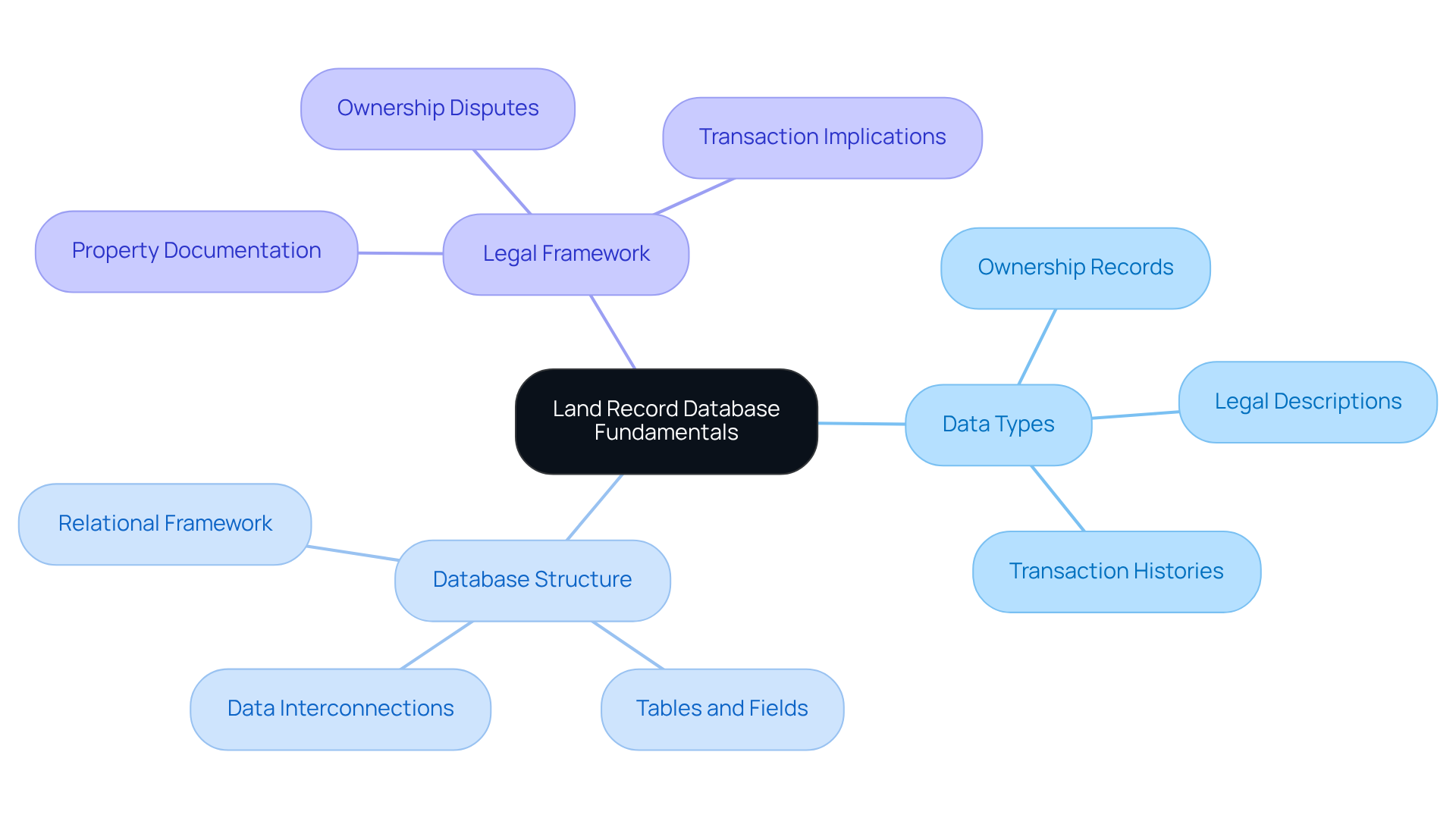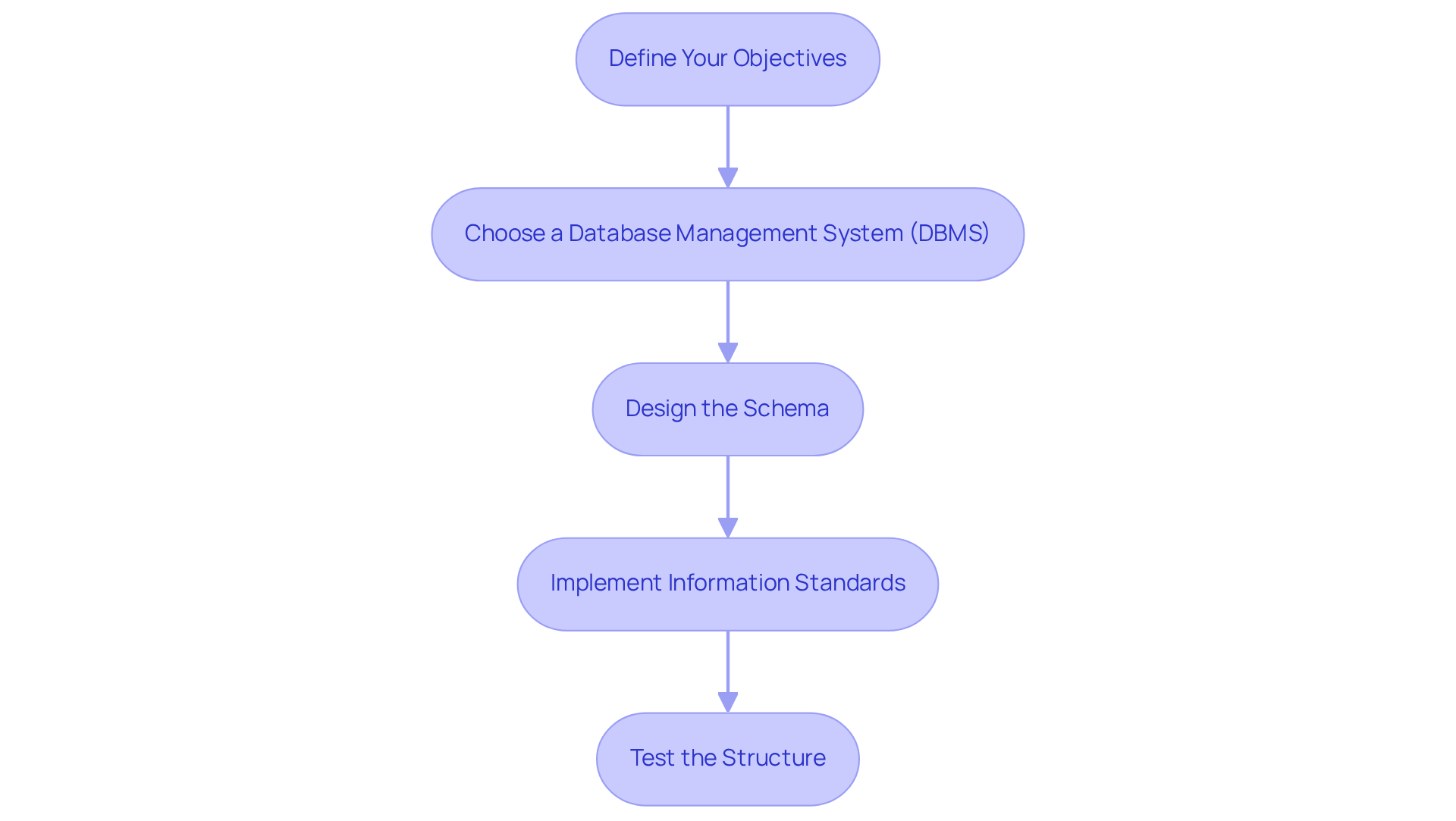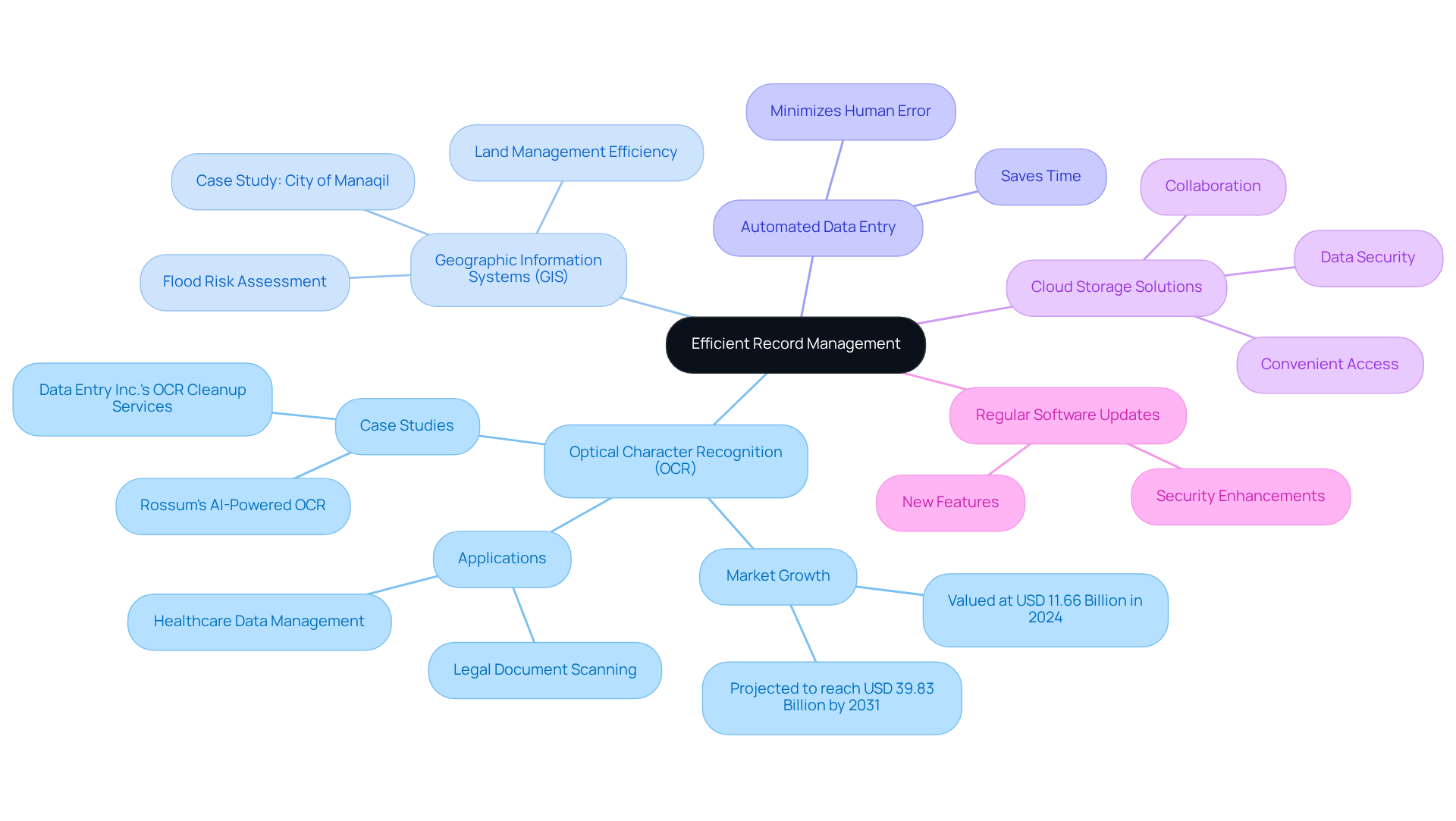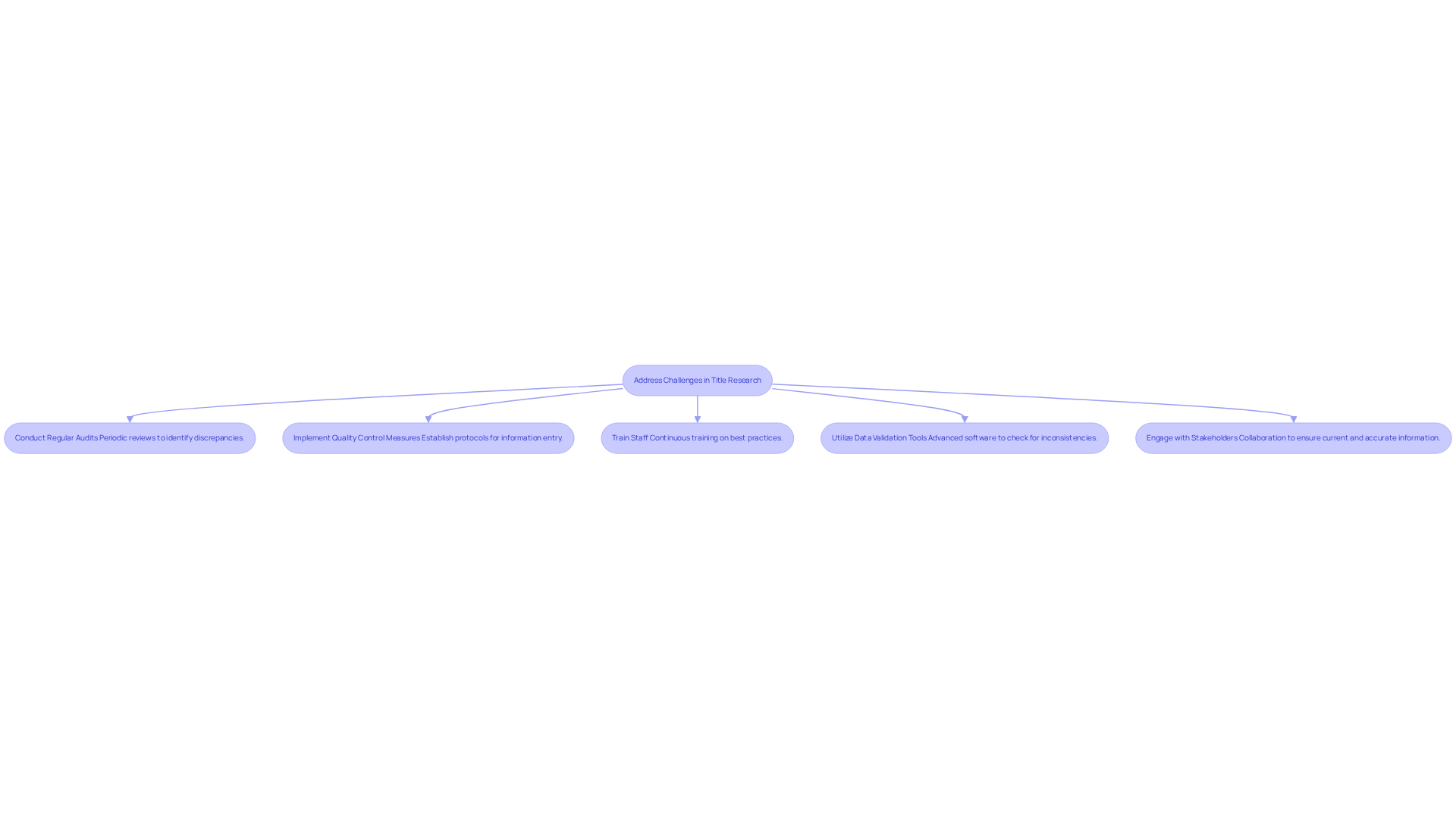Overview
Counties effectively manage land record databases by establishing a structured database framework, leveraging technology, and addressing challenges related to title research and record accuracy. The significance of accurate title research cannot be overstated, as it forms the foundation for reliable property documentation.
However, counties face challenges such as ensuring record accuracy and overcoming obstacles in title research. To address these issues, essential steps include:
- Defining objectives
- Selecting appropriate database management systems
- Implementing advanced technologies like OCR and GIS
These solutions collectively contribute to improved data management and reliability in property documentation.
Introduction
Land record databases serve as the backbone of property management, acting as vital repositories of ownership, boundaries, and transaction histories. Effectively managing these databases not only enhances operational efficiency but also ensures legal compliance and accuracy in property documentation. However, with the increasing complexity of data and the rapid advancement of technology, counties face significant challenges in maintaining reliable and accessible land records. This article delves into best practices and innovative strategies for establishing and managing land record databases, equipping readers with the knowledge to tackle these pressing issues head-on.
Understand Land Record Database Fundamentals
serve as essential platforms that encompass data related to , boundaries, and transactions. To manage these databases effectively, it is crucial to grasp , including:
- Data Types: Acquaint yourself with the various data types stored, such as ownership records, legal descriptions, and .
- : Understand the relational framework of databases, including tables, fields, and the interconnections among different data sets.
- Legal Framework: Recognize the of property documentation, particularly their role in ownership disputes and transactions.
By mastering these fundamentals, you will be well-equipped to navigate the complexities of property management.

Establish Your Land Record Database Structure
To establish a robust structure, adhere to the following steps:
- Define Your Objectives: Clearly outline the information that needs to be stored and its intended use. This foundational step will inform your database design and ensure it aligns with organizational goals.
- Choose a : Select a DBMS that fits your requirements. Options such as SQL Server, PostgreSQL, or cloud-based solutions can provide the necessary functionality and scalability for managing land records effectively. As highlighted by Hilary Mason, ',' which emphasizes the significance of choosing the appropriate tools for efficient .
- Design the Schema: Create a schema that includes tables for properties, owners, transactions, and other relevant information. Clearly define the relationships between these tables to facilitate efficient information retrieval and integrity. A well-organized framework is crucial, as it enables improved information arrangement and accessibility.
- : Establish entry standards to maintain consistency across the database. This involves establishing naming conventions, types of information, and validation rules to ensure quality and reliability of the information. As stated by Jennifer Shin, ',' which can also pertain to the teamwork required in upholding information standards.
- Test the Structure: Before deployment, thoroughly examine the framework using sample information. This testing phase is crucial for and refining the system for optimal performance. Effective applications, like those emphasized in case studies, show that comprehensive testing can greatly improve the dependability of the data system.
By following these steps, you will create a structured and efficient database that effectively meets your organization's requirements, ultimately and enhancing data management and accessibility. Integrating these practices not only conforms to industry standards but also prepares your organization for sustained success in managing property documents.

Leverage Technology for Efficient Record Management
To leverage technology for , consider the following tools and strategies:
- : Implement OCR technology to digitize paper records, making them searchable and easier to manage. The OCR market was valued at USD 11.66 billion in 2024 and is projected to reach USD 39.83 billion by 2031, underscoring the across various sectors, particularly in BFSI, which holds a significant market share.
- Geographic Information Systems (GIS): Employ GIS to spatially visualize terrain information, aiding in decision-making and planning. A successful case study in the City of Manaqil exemplifies how and improved land management efficiency.
- : Leverage software that automates data entry processes to minimize human error and save valuable time.
- Cloud Storage Solutions: Utilize and collaboration among team members, ensuring information remains secure and backed up.
- : Maintain up-to-date software and systems to benefit from new features and security enhancements.
As noted by a VMR Analyst, "the increasing demand for software solutions is significantly impacting the OCR systems market by fostering innovation and enhancing functionality." By integrating these technologies, you can streamline your property management processes, leading to improved efficiency and precision.

Address Challenges in Title Research and Record Accuracy
To effectively address the challenges inherent in and ensure the accuracy of records, it is imperative to implement the following strategies:
- : Periodic reviews of records are essential for identifying discrepancies and ensuring completeness. Regular audits significantly enhance the accuracy of land records, allowing for timely corrections before they escalate into larger issues.
- Implement : Establishing robust protocols for information entry and updates minimizes errors. This includes standardized procedures for verifying information prior to documentation, which is crucial for maintaining high-quality records.
- : Continuous training programs are vital for equipping staff with best practices in and the latest technological tools. This not only enhances individual performance but also fosters a culture of accuracy and accountability within the organization.
- Utilize : Employing advanced software solutions that automatically check for inconsistencies or errors can streamline the data management process. These tools enhance the reliability of documentation by flagging potential issues for review.
- : Collaboration with local government agencies and other parties ensures that information remains current and accurate. This partnership promotes the exchange of information and resources, further improving the reliability of .
By proactively addressing these challenges, organizations can significantly enhance the reliability of their land records, leading to more efficient and better decision-making.

Conclusion
Effectively managing land record databases is critical for ensuring accurate property documentation and facilitating seamless transactions. This article emphasizes the significance of grasping the fundamentals of land information systems, establishing a robust database structure, leveraging technology for efficient record management, and addressing challenges in title research and record accuracy. By mastering these elements, counties can elevate their land management practices and enhance overall efficiency.
Key strategies include:
- Defining clear objectives for database design
- Selecting suitable database management systems
- Implementing information standards to uphold data integrity
Furthermore, utilizing advanced technologies such as Optical Character Recognition (OCR) and Geographic Information Systems (GIS) can streamline processes and minimize errors. Regular audits and staff training play a vital role in ensuring the accuracy and reliability of land records, empowering organizations to make informed decisions based on precise information.
The importance of effective land record management is paramount. As counties navigate the complexities of property ownership and transactions, the adoption of best practices and innovative technologies will prove crucial. Embracing these strategies not only enhances operational efficiency but also fosters trust and transparency in property dealings. For counties aiming to improve their land record databases, taking proactive measures today will yield significant long-term benefits for both their operations and the communities they serve.
Frequently Asked Questions
What are land information systems?
Land information systems are platforms that contain data related to property ownership, boundaries, and transactions.
What types of data are stored in land record databases?
Land record databases store various types of data, including ownership records, legal descriptions, and transaction histories.
What is the importance of understanding database structure?
Understanding database structure is important because it involves the relational framework of databases, including tables, fields, and the interconnections among different data sets.
Why is it necessary to recognize the legal framework of property documentation?
Recognizing the legal framework is necessary because it helps in understanding the legal implications of property documentation, especially in the context of ownership disputes and transactions.
How can mastering these fundamentals benefit property management?
Mastering these fundamentals equips individuals to navigate the complexities of property management effectively.




